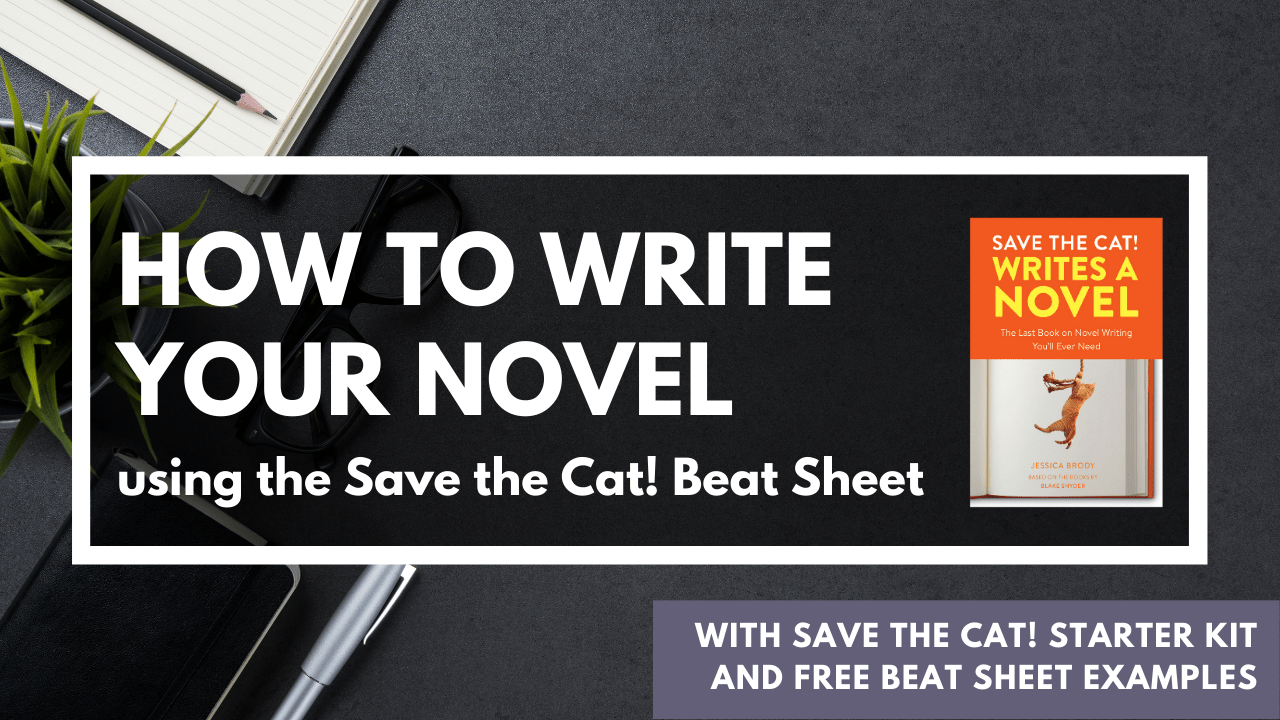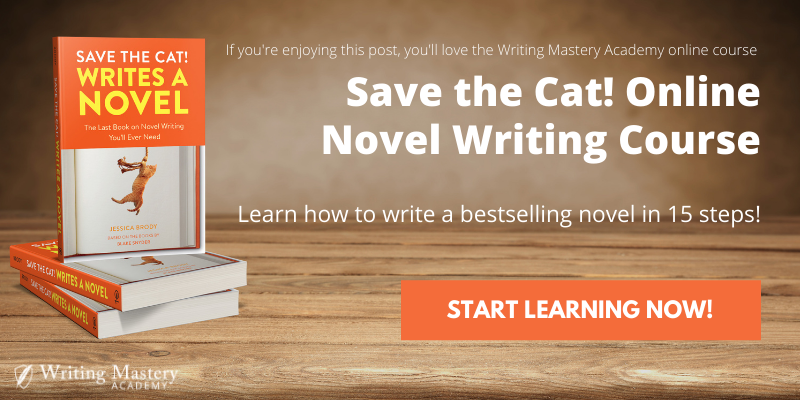How to Write Your Novel Using the Save the Cat Beat Sheet

Writing a book outline is hard. Writing a book in general is hard. Plotting a compelling character arc and figuring out what happens next is a challenge for any writer, professional and newbie alike! Fortunately, I’m here to make it WAY easier for you. This blog post features my tried and true 15 steps to writing a book. Also known as the Save the Cat! Beat Sheet. You can use this handy novel-writing template to outline, write, or revise any novel of any genre.
You might have read the paragraph above and thought, What??? Only 15 Steps? And that’s right. ONLY 15 steps and you have a full novel outline. And here’s the best part. These aren’t just 15 random steps. These are the 15 “plot points” that are found in almost every successful novel ever written. Whether the author intended them to be or not.
SERIOUSLY!?
Seriously. I’ve studied story for a long time. I’ve read a lot of novels. And after having written over twenty of my own (all published by major publishers like Simon & Schuster, Penguin Random House, and Macmillan), I can tell you that there is a definite pattern or structure at the heart of every successful novel. I call it the “Secret Storytelling Code”. And it’s this very code that is the basis of the story structure method that I teach to other writers called Save the Cat!
I’m guessing you’ve actually already noticed this secret storytelling code or structure on your own. Maybe without even realizing it.
For instance, have you ever noticed that in every great book or movie, something BIG always seems to happen right around 10% of the way into the story? Or that at 20% of the way in, the story seems to change direction and new characters and worlds and ideas are introduced? Or that at around halfway through the story is when the BIG twists are revealed or the big bombs are dropped (both literal and figurative)?
This isn’t a coincidence. This is the secret storytelling code in action. Essentially it’s the blueprint of what makes up a good story. And it can be broken down into 15 essential plot points. Or what I like to call “beats.” And if you learn those 15 beats and use them to outline and write your own story, you’re almost guaranteed to write a successful one.
Because this blueprint is not only for writing a successful plot. It’s also a blueprint for charting a successful character arc, writing characters that readers will root for, and ensuring that the pacing of your story is always engaging, exciting, and full of conflict and high stakes (regardless of whether you’re writing a quieter contemporary novel or a high-octane thriller.)
And in this post, I’m going to share with you exactly what they are and where they go in your story, so that you can start applying them to your own fiction writing.
So, without further ado, let’s break down your novel using the Save the Cat! Beat Sheet and figure out what should go where.
The Save the Cat! Beat Sheet
Beat #1: Opening Image. (0-1)%
This is the first beat of Act 1 and it serves as a “before” snapshot of your main character (who from here on out I will refer to as the “hero” of your story), where you visually show, in a single scene, who your hero is and what their world or life is like.
Beat #2: Theme Stated (5%)
This is where a statement is made by a character (typically not the hero) that hints at what the hero’s arc will be (that is, what the hero must learn/discover before the end of the book). This can also be referred to as a “life lesson.”
Beat #3: Setup (1% – 10%)
These scenes are used to explore the hero’s status quo life and all its flaws. This is where the reader learns more about what the hero’s life looks like before its epic transformation, including how your hero’s life is flawed in some way. Here we also introduce other supporting characters and the hero’s primary goal. But most important, we show the hero’s reluctance to change (aka learn the theme or life lesson) while also hinting at the stakes at risk should the hero not change.
Beat # 4 – Catalyst (10%)
At 10%, an inciting incident (or life-changing event) should happen to the hero, which will catapult them into a new world or new way of thinking. This is an action beat that should be big enough to prevent the hero from being able to return to their status quo life. (things like break-ups, deaths, firings, and invitations are popular choices.)
Beat #5: Debate (10% to 20%)
After the Catalyst, the hero usually takes multiple scenes or chapters to react to what happened in the Catalyst. This is a sequence in which the hero debates what they will do next. It’s usually presented in the form of a question (such as “Should I go?” or “What do I do?”). The purpose of this beat is to show the hero’s reluctance to change.
Beat #6: Break Into 2 (20%)
This is the moment when the hero decides to accept the call to action, leave their comfort zone, try something new, or venture into a new world or new way of thinking. It’s a decisive action beat that separates the status quo world of Act 1 from the new “upside-down” world of Act 2, which we are now in! It’s at this moment that a new or modified goal is typically introduced, something that the hero is pursuing through the first half of Act 2.
Beat #7: B Story (22%)
At this point in the story, we introduce a new character or characters who will ultimately serve to help the hero learn the theme or life lesson. This can also be referred to as a helper character, and it can come in the form of a love interest, nemesis, mentor, family member, friend, or other!
Beat #8 : Fun and Games (20% to 50%)
In this long sequence of multiple scenes or chapters is where we see the hero in their new “upside down” world of Act 2. They’re either generally loving it or hating it. Succeeding or floundering. We want to see the hero pursuing that goal you set up at the Break into 2, so this is where you show the hero either making strides to achieve that goal or struggling to achieve that goal. This beat is also called the “promise of the premise” because it’s the section of the story that represents the “hook” of the novel, in other words, (why the reader picked up the novel in the first place).
Beat #9: Midpoint (50%)
This is literally the middle of the novel where the Fun and Games culminates in either a “false victory” (the hero has thus far been succeeding and/or has achieved their goal) or a “false defeat” (the hero has thus far been floundering and/or has lost their goal). But something else should happen here to raise the stakes and push the hero forward, ultimately toward real change. (Plot twists, time clocks, ramp-ups of the love story are popular choices.)

Beat #10: Bad Guys Close In (50% to 75%)
If the Midpoint was a false victory, this section of the story will generally be a downward path where things get progressively worse for the hero. If the Midpoint was a false defeat, this section will generally be an upward path where things seem to get progressively better for the hero. But regardless of path, the hero’s deep-rooted flaws (or internal bad guys) are closing in. After the Midpoint, the hero typically has either a new or modified goal to pursue throughout this beat.
Beat #11: All Is Lost (75%)
This moment is the lowest point of the novel. It’s an action beat where something happens to the hero that, combined with their internal bad guys, pushes the hero to rock bottom. There’s typically a “whiff of death” during this beat, meaning something dies here (either literally or metaphorically) to symbolize the “death of the old hero” and upcoming “rebirth of a transformed hero”
Beat #12: Dark Night of the Soul (75% to 80%)
This is another reaction beat where the hero takes time to process everything that’s happened thus far. The hero should be worse off than at the start of the novel. This feels like the darkest hour for the hero, but it’s just darkness before the dawn, or the moment right before the hero finds a solution to their problems, but also finally learn their theme or life lesson.
Beat #13: The Break Into 3 (80%)
The “aha!” moment. This is where the hero realizes what they must do to not only fix the problems created in Act 2, but more important, fix themself and be “reborn” as an improved version of themselves. The character arc is nearly complete.
Beat #14: The Finale (80% to 99%)
Now in Act 3, the hero must prove that they really have learned the theme and have transformed. To do that we, show them enacting the plan they came up with in the Break Into 3. Bad guys are destroyed, flaws are conquered, lovers are reunited. Not only is the hero’s world saved, but it’s a better place than it was before.
Beat #15: Final Image (99% to 100%)
A mirror to the Opening Image, this is the “after” snapshot of who the hero is after going through this epic and satisfying transformation. In this final beat we show a visual representation of the hero’s life after this exciting journey has changed them for the better.
So, there you have it. The 15 beats or plot points that make up almost all successful stories EVER told! Apply this blueprint or outline to your own novel and you’re sure to have a dynamic plot with effective pacing, worthy stakes, and a compelling character arc. Everything you could ever want in a novel!
Want examples of all these beats in action?
Download my free Save the Cat! Starter Kit PDF which comes a handy, printable list of ALL of these 15 beats plus 3 full-length beat sheets (or plot analyses), showing you how the beats appear in some popular bestselling novels.
And If you want to dive deeper into these 15 beats and the Save the Cat! Method, be sure to check out my book, SAVE THE CAT! WRITES A NOVEL, available wherever books are sold, or my Save the Cat! Online Novel Writing course, available in the Writing Mastery Academy.
Happy Writing and Plotting!
Filed under: Big News Save the Cat Tips for Writers Writing Mastery Tagged with: beat sheet novel outlines novel writing revision save the cat set up STC Starter Kit (LMAP) Tips for Writers writing mastery writing tips
-->